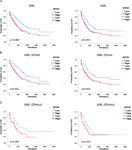Journal of Molecular Medicine ( IF 4.7 ) Pub Date : 2024-02-10 , DOI: 10.1007/s00109-023-02409-1 Jiajia Pan , Yungui Wang , Shujuan Huang , Shihui Mao , Qing Ling , Chenying Li , Fenglin Li , Mengxia Yu , Xin Huang , Jiansong Huang , Yunfei Lv , Xia Li , Wenle Ye , Huafeng Wang , Jinghan Wang , Jie Jin

|
Abstract
Previous evidence has confirmed that branched-chain aminotransferase-1 (BCAT1), a key enzyme governing branched-chain amino acid (BCAA) metabolism, has a role in cancer aggression partly by restricting αKG levels and inhibiting the activities of the αKG-dependent enzyme family. The oncogenic role of BCAT1, however, was not fully elucidated in acute myeloid leukemia (AML). In this study, we investigated the clinical significance and biological insight of BCAT1 in AML. Using q-PCR, we analyzed BCAT1 mRNAs in bone marrow samples from 332 patients with newly diagnosed AML. High BCAT1 expression independently predicts poor prognosis in patients with AML. We also established BCAT1 knockout (KO)/over-expressing (OE) AML cell lines to explore the underlying mechanisms. We found that BCAT1 affects cell proliferation and modulates cell cycle, cell apoptosis, and DNA damage/repair process. Additionally, we demonstrated that BCAT1 regulates histone methylation by reducing intracellular αKG levels in AML cells. Moreover, high expression of BCAT1 enhances the sensitivity of AML cells to the Poly (ADP-ribose) polymerase (PARP) inhibitor both in vivo and in vitro. Our study has demonstrated that BCAT1 expression can serve as a reliable predictor for AML patients, and PARP inhibitor BMN673 can be used as an effective treatment strategy for patients with high BCAT1 expression.
Key messages
-
High expression of BCAT1 is an independent risk factor for poor prognosis in patients with CN-AML.
-
High BCAT1 expression in AML limits intracellular αKG levels, impairs αKG-dependent histone demethylase activity, and upregulates H3K9me3 levels.
-
H3K9me3 inhibits ATM expression and blocks cellular DNA damage repair process.
-
Increased sensitivity of BCAT1 high expression AML to PARP inhibitors may be used as an effective treatment strategy in AML patients.
中文翻译:

BCAT1 的高表达通过抑制 DNA 损伤反应使 AML 细胞对 PARP 抑制剂敏感
摘要
先前的证据已证实,支链氨基转移酶-1 ( BCAT1 ) 是控制支链氨基酸 (BCAA) 代谢的关键酶,通过限制αKG水平和抑制αKG依赖性酶的活性,在癌症侵袭中发挥作用。家庭。然而, BCAT1在急性髓系白血病 (AML) 中的致癌作用尚未完全阐明。在这项研究中,我们研究了BCAT1在 AML 中的临床意义和生物学意义。我们使用 q-PCR 分析了332 名新诊断的 AML 患者的骨髓样本中的BCAT1 mRNA。 BCAT1高表达独立预测 AML 患者的不良预后。我们还建立了BCAT1敲除(KO)/过表达(OE)AML 细胞系来探索潜在机制。我们发现BCAT1影响细胞增殖并调节细胞周期、细胞凋亡和 DNA 损伤/修复过程。此外,我们证明BCAT1通过降低 AML 细胞中的细胞内αKG水平来调节组蛋白甲基化。此外, BCAT1的高表达增强了AML细胞在体内和体外对聚(ADP-核糖)聚合酶(PARP)抑制剂的敏感性。我们的研究证明BCAT1表达可以作为AML患者的可靠预测因子,PARP抑制剂BMN673可以作为BCAT1高表达患者的有效治疗策略。
关键信息
-
BCAT1高表达是CN-AML患者预后不良的独立危险因素。
-
AML 中BCAT1 的高表达限制了细胞内 αKG 水平,损害 αKG 依赖性组蛋白去甲基酶活性,并上调 H3K9me3 水平。
-
H3K9me3 抑制 ATM 表达并阻断细胞 DNA 损伤修复过程。
-
BCAT1高表达 AML 对 PARP 抑制剂的敏感性增加可作为 AML 患者的有效治疗策略。



























 京公网安备 11010802027423号
京公网安备 11010802027423号